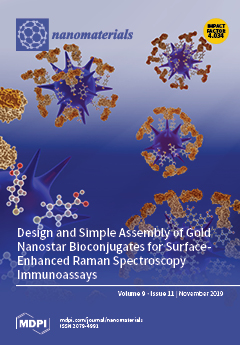Early diagnosis of disease and follow-up of therapy is of vital importance for appropriate patient management since it allows rapid treatment, thereby reducing mortality and improving health and quality of life with lower expenditure for health care systems. New approaches include nanomedicine-based diagnosis combined with therapy. Nanoparticles (NPs), as contrast agents for in vivo diagnosis, have the advantage of combining several imaging agents that are visible using different modalities, thereby achieving high spatial resolution, high sensitivity, high specificity, morphological, and functional information. In this work, we present the development of aluminum hydroxide nanostructures embedded with polyacrylic acid (PAA) coated iron oxide superparamagnetic nanoparticles, Fe
3O
4@Al(OH)
3, synthesized by a two-step co-precipitation and forced hydrolysis method, their physicochemical characterization and first biomedical studies as dual magnetic resonance imaging (MRI)/positron emission tomography (PET) contrast agents for cell imaging. The so-prepared NPs are size-controlled, with diameters below 250 nm, completely and homogeneously coated with an Al(OH)
3 phase over the magnetite cores, superparamagnetic with high saturation magnetization value (Ms = 63 emu/g-Fe
3O
4), and porous at the surface with a chemical affinity for fluoride ion adsorption. The suitability as MRI and PET contrast agents was tested showing high transversal relaxivity (r
2) (83.6 mM
−1 s
−1) and rapid uptake of
18F-labeled fluoride ions as a PET tracer. The loading stability with
18F-fluoride was tested in longitudinal experiments using water, buffer, and cell culture media. Even though the stability of the
18F-label varied, it remained stable under all conditions. A first in vivo experiment indicates the suitability of Fe
3O
4@Al(OH)
3 nanoparticles as a dual contrast agent for sensitive short-term (PET) and high-resolution long-term imaging (MRI).
Full article






